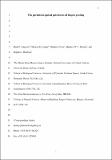| dc.contributor.author | Johnson, Mark P. | en |
| dc.date.accessioned | 2009-09-28T10:55:51Z | en |
| dc.date.available | 2009-09-28T10:55:51Z | en |
| dc.date.issued | 2008 | en |
| dc.identifier.citation | Johnson M.P., Hanley M.E., Frost N.J., Mosley MWJ, and Hawkins S.J. 2008. The persistent spatial patchiness of limpet grazing. Journal of Experimental Marine Biology and Ecology. 365, 136 141. | en |
| dc.identifier.uri | http://hdl.handle.net/10379/315 | en |
| dc.description.abstract | The characteristic variability of grazing has potential consequences for intertidal productivity and community structure, particularly as many of the underlying functional relationships are thought to be non linear. As a first approximation, it can be hypothesised that grazing is patchy over short time periods before a more uniform coverage is established over longer time scales. This prediction is supported by relatively short term observations previously made of limpet foraging. We used eight arrays of wax disks on each of four shores to test the hypothesis that grazing is patchy in the short term, but that this pattern is lost as the pattern of grazing averages out over longer time scales. Wax disk arrays were exposed for two weeks at a time for a period of six weeks in 2001 and in 2002 using the same set of disk holes each time. Grazing at the same disk location could therefore be measured over two weeks and over longer periods by averaging successive deployments. We used all three successive deployments to estimate the average grazing at each disk location over a six week period in 2001 and 2002. All six deployments were used to characterise the pattern of grazing at longer time scales. The spatial pattern of grazing in arrays was summarized using semivariogram analyses. For two-week deployments, the average standardized semivariance of grazing for disks separated by 20 cm was less than one. This pattern implies spatial autocorrelation of grazing at this scale. There was no support for the hypothesis that small scale patchiness in grazing would disappear over time. The average strength of spatial autocorrelation increased when data were integrated over longer periods. A preliminary analysis indicated that the degree of autocorrelation within arrays increased with grazing intensity at short time scales. Surface roughness disrupted autocorrelation of grazing over both short and long time scales. The persistent patchiness of grazing is likely to have implications for biofilm productivity, particularly on smoother shores.
Keywords: Patella vulgata; semivariogram; spatial autocorrelation; topography; wax disk | en |
| dc.format | application/pdf | en |
| dc.language.iso | en | en |
| dc.publisher | Elsevier | en |
| dc.rights | Attribution-NonCommercial-NoDerivs 3.0 Ireland | |
| dc.rights.uri | https://creativecommons.org/licenses/by-nc-nd/3.0/ie/ | |
| dc.subject | Patella vulgata | en |
| dc.subject | Wax disk | en |
| dc.subject | Topography | en |
| dc.subject | Spatial autocorrelation | en |
| dc.subject | Semivariogram | en |
| dc.subject.lcsh | Grazing | en |
| dc.title | The persistent spatial patchiness of limpet grazing | en |
| dc.type | Article | en |
| dc.identifier.doi | doi:10.1016/j.jembe.2008.08.006 | en |
| dc.local.publishedsource | http://dx.doi.org/doi:10.1016/j.jembe.2008.08.006 | en |
| dc.local.publisherstatement | Elsevier | en |
| dc.description.peer-reviewed | peer-reviewed | en |
| nui.item.downloads | 877 | |


